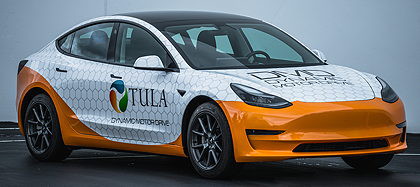- Home » News » Technology News
Software-based motor control ‘boosts efficiency by up to 3%’

A Californian company has demonstrated a software-based motor control technology which, it claims, can boost motor efficiencies while avoiding the need for rare-earth materials. At a symposium in Austria, Tula Technology showed a Tesla Model 3 vehicle retrofitted with an externally excited synchronous motor (EESM) running its Dynamic Motor Drive (DMD) software, and claimed that this could cut the EV’s energy consumption by up to 3%.
The technology could also be applied to motors used in industrial applications.
In EV applications, the DMD technology – which involves an “optimised pulsing strategy” – is claimed to reduce energy consumption, while having no effect on vehicle noise or vibration. The efficiency improvement could allow the use of smaller or cheaper batteries, or help to increase electric vehicle ranges.
When torque requests are low, DMD pulses the magnetic field at optimal efficiency, cutting core and inverter switching losses by up to 25%. A conventional motor running continuously cannot deliver such efficiencies, says Tula, adding that DMD makes EESMs as efficient at low speeds as they are at high speeds.
The company reports that it has proven the feasibility of DMD in two vehicles with different electric propulsion systems. In 2022, its first DMD application was based on a Chevrolet Bolt vehicle with an unmodified permanent magnet synchronous motor (PMSM) drive. Tests showed that the system improved the Bolt’s energy consumption, while maintaining its drive quality.
In its latest demo, Tula has retrofitted a Tesla Model 3’s PMSM with a wound rotor to create an EESM. It then incorporated its DMD control logic to reduce energy consumption and improve system efficiency.

Tula argues that the combination of EESM and DMD will help to eliminate the need for costly rare-earth materials, while being highly competitive in terms of both efficiency and cost. It can also improve the efficiency of PMSMs, which account for about 90% of existing EV propulsion systems. The technology is scalable, adaptable, cost-competitive and sustainable, making electric propulsion more efficient.
In industrial applications, DMD can be used to improve the efficiency of inverter-controlled induction motors, achieving IE5 efficiency levels. It can also be used with lower-cost synchronous reluctance machines to achieve higher efficiencies than induction motors. This combination approaches the efficiencies of interior permanent magnet motors, but without the costs and supply-chain risks associated with using rare-earth magnets.
Tula Technology, founded in 2008, offers efficiency-boosting software controls for various propulsion technologies including electric, hybrid, petrol, diesel and alternative fuels. It has a portfolio of more than 400 global patents, issued and pending. The privately-owned company’s backers include GM Ventures and BorgWarner.
Tula Technology: LinkedIn






